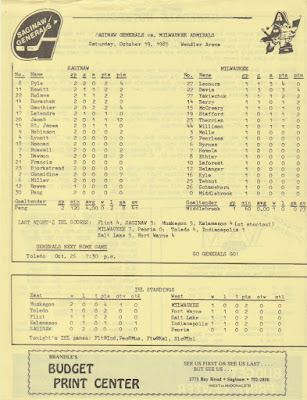 |
| 1985-86 IHL Regular Season: Generals vs. Milwaukee Admirals |
The Generals were a farm team of three NHL clubs that season. The Chicago Black Hawks, Montreal Canadiens and Buffalo Sabres sent prospects to the Tri-Cities in 1985-86.
A couple familiar faces for Saginaw fans were with the Generals that season. Former Gears power forward Dennis Desrosiers was in his third season behind the Generals bench. Rosie took over in 1983-84 and led the Generals to their first-ever Turner Cup title. Joining him on the bench is former teammate Dave Westner, who is now an assistant coach. Rounding out the former Gears trio was forward Warren Holmes, who was part of Saginaw's last Turner Cup win in 1981.
The Generals had been one of the stronger teams in the IHL the previous two years, and 1985-86
 |
| Stats sheet for Opening Night 1985 |
Judging by the statistics that season, the Saginaw Generals were more of a defensive team, as they allowed the second-fewest goals in the league (285). They used two goaltenders that season, as veteran Rick Knickle and Black Hawks prospect Darren Pang alternated. On offense, Saginaw was near the bottom in production, scoring 318 goals. They were led by Flint holdover Jeff Pyle, who scored 39 goals and 109 points. Future Black Hawk Brian Noonan also scored 39 goals (78 points) and Kevin Robinson was the other 30-goal scorer (34).
Qualifying for the Turner Cup Playoffs was not a difficult task for the Generals. The franchise never missed the postseason after their inaugural campaign, an impressive run for any level of hockey. Success in the postseason, however, was a different story. The Generals were often bounced out of the playoffs by either the first or second round, and won only one Turner Cup (1984). Saginaw would get it's first taste of playoff hockey in four years when the Generals opened up with the Kalamazoo Wings. The Wings were in second place, 10 points ahead of the Generals that season and had one of the top offenses in the league. The Generals shot down the K-Wings in six games to advance to the Eastern Division Finals. There, Saginaw ran into the powerful Muskegon Lumberjacks, who were second overall in the league and just missed winning the Cup the previous year. The Lumberjacks advanced in five games, but the series was competitive, as the Jacks outscored the Generals by only 20-18. Muskegon went on to crush the Fort Wayne Komets in four straight to win the Turner Cup.
 |
| Iron-On Patch giveaway |
 Local advertisements include NBD Bank, Schaefer &
Local advertisements include NBD Bank, Schaefer & Bierlein Dodge Chrysler Plymouth dealer of Frankenmuth, WBCM 1440 AM (radio home of the Generals), Delta College and Wolohan Lumber. The back cover had a full-color ad for the 1985 Buick Skylark.
Aftermath: The team would keep the name "Generals" for another season, but switch to "Saginaw Hawks" after becoming the primary affiliate of the Chicago Black Hawks. Chicago pulled it's agreement after the 1988-89 season, citing poor attendance and a desire for a more professional environment, opting for the Indianapolis Ice. The Hawks folded and hockey would not return to the Tri-Cities until the arrival of the Colonial Hockey League's Saginaw Wheels in 1994.
Comments
Post a Comment